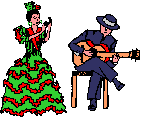 |
Spain | Travel | Regions | Cities | Coasts | Islands | Culture |
| Spain / Country and Culture / Flamenco / History |
|
| More Information | ||
| Destinations | ||
| Plan your Trip | ||
| ||||||
 Flamenco's origins are a subject of much debate because it has only been documented for the past two hundred years, and the word Flamenco, which applies to the song, the dance and the guitar, did not come into use until the 18th century. Much of what we know before this time comes from stories that have been passed down through families, in a similar way to the flamenco song itself.
Flamenco's origins are a subject of much debate because it has only been documented for the past two hundred years, and the word Flamenco, which applies to the song, the dance and the guitar, did not come into use until the 18th century. Much of what we know before this time comes from stories that have been passed down through families, in a similar way to the flamenco song itself. Although many of the details of the development of flamenco are lost in history, it is certain that it originated in Andalusia and that from the VIII to the XV centuries, when Spain was under Arab domination, their music and musical instruments were modified and adapted by Christians and Jews, and later by gipsies becoming a hybrid music separate from the musical forms which created it. Between 1765 and 1860, the first Flamenco-schools were created in Cadiz, Jerez de la Frontera and Triana (Seville). In this epoch Flamenco dance started to have its firm position in the ballrooms. Early Flamenco seems to have been purely vocal, accompanied only by rhythmical clapping of hands, toque de palmas. It was left to dedicated composers, as Julián Arcas, to introduce guitar playing. During its Golden Age (1869-1910) Flamenco was developed in the epoch's numerous music cafés (cafés cantantes) to its definitive form. Also the more serious forms expressing deep feelings (cante jondo) date from then. Flamenco dance arrived to its climax, being the major attraction for the public of those cafés cantantes. Guitar players featuring the dancers increasingly gained a reputation.  The time from 1910 to 1955 Flamenco singing is marked by the ópera flamenca, with an easier kind of music such as fandangos and cantes de ida y vuelta. The latter clearly showed South American influences. From 1915 on Flamenco shows were organized and performed all over the world. Anyhow, not everybody was enchanted with that development and intellectuals such as Falla organized 1922 in Granada a contest to promote "pure" cante jondo. 1955 started a sort of Flamenco Renaissance, with the great performer Antonio Mairena being its key figure. Outstanding dancers and soloists soon made their way out of the small tablaos, successors to the early cafés cantantes, to the great theatres and concert houses. It was now that guitar players acquired a great protagonism, and their playing arrived to maturity. The Flamenco guitar which formerly was just featuring the dancers arrived to be a soloist art form. Great virtuosos like Paco de Lucia played an essential roll in this development. Massmedia have brought Flamenco to the world stage, but deeply it has always been and will remain an intimate kind of music. That's why one of the most authentic Flamenco you may experience is in a juerga (flamenco party) with a small group of friends, at midnight somewhere in the South of Spain, when there is nothing around but the voice, the guitar and the body of a dancer moving in the moonlight. More about Flamenco: What is Flamenco? | Flamenco Artists | Flamenco Festivals | Flamenco Books and Music-CDs |